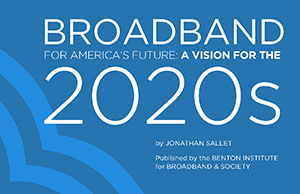Foreword
Broadband has quickly emerged as the most transformative technology of our generation—delivering opportunities and strengthening communities. As broadband’s capability to change lives and society has grown, so too has it become the driving mission of the Benton Institute for Broadband & Society. To further expand opportunity, we offer this new vision and agenda for action.
The purpose of Broadband for America’s Future: A Vision for the 2020s is to collect, combine, and contribute to a national broadband agenda for the next decade. Our work is built on the lessons of communities, publicinterest advocates, government officials, and industry experts who have labored to expand broadband’s reach to everyone in the United States. They deserve credit for their investments and innovations, and we have attempted to reflect their accomplishments and ideas while contributing Benton’s own insights—insights built n a body of work stretching back to the 1980s.
Connecting our entire nation through High-Performance Broadband will bring remarkable economic, social, cultural, and personal benefits. In the Digital Age, open, affordable, robust broadband is the key to all of us reaching for—and achieving—the American Dream.
Since the mid-1990s, the U.S. has struggled with a persistent dilemma called the digital divide—the unfortunate reality that for too many people, meaningful connectivity is out of reach. As we enter a new decade, America encounters three interlocking challenges:
Closing the Geographic Divide. In both urban and rural areas, millions of people in America are waiting for the deployment of robust broadband networks. Broadband is advancing in some places, which is good, but the fact is that we don’t have an accurate count of how many people are on the wrong side of the digital divide and where they live. What we know is that places without robust broadband are falling further and further behind. We cannot let where we live determine our potential to connect.
Harnessing Competition. Even in areas that are served by broadband networks, consumers lack choice of providers. Without competition, consumers are threatened with artificially high prices, lower-quality service, and little innovation. We cannot let lack of choice harm consumers.
Boosting Affordability and Adoption. For too many people, the cost of broadband is too high and the digital skills needed to use broadband effectively are absent. The result is people disconnected from continuing their education, gaining new job skills, and finding employment. We cannot let lack of access or affordability deprive people of opportunity.
Confronting these divides requires bold leadership and informed solutions. Community leadership is key since local governments and anchor institutions are closest to local needs and have earned Americans’ confidence and trust. With the right choices, these are the people and institutions who can link broadband to broader economic and social outcomes and make the greatest impact on their communities.
Over the past year we’ve talked with leading experts and community leaders. Now we begin a new yearlong effort to enlist the voices of broadband leaders in an ongoing discussion on how public policy can close the digital divide and extend digital opportunity everywhere.
Please join us in this conversation.
Adrianne B. Furniss, Executive Director
Benton Institute for Broadband & Society

